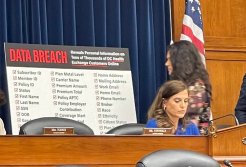State-run exchanges were boom or bust

The data is still being crunched on the first enrollment period of the Affordable Care Act, but one trend has emerged: for states that built their own exchange, the results have been feast or famine with the federal model falling somewhere in-between.
In an interview with StateScoop, Bill Melville, an analyst with Massachusetts-based Decision Resources Group who has researched the state health care insurance exchanges, said the biggest factor in the success of an exchange ended up being technology.
“For those states that got the technology aspect right, they were able to provide an exchange that was best suited to their individual state needs,” Melville said. “On the other hand, the states that struggled with the technology part saw the most problems, and their numbers in part showed that.”
As part of the Affordable Care Act, states were given the choice to either opt into the federal government’s exchange or build their own. Most of the states went with the federal government’s solution, but 15 , including the District of Columbia, decided to build their own.
Some states saw great success. Melville pointed to California as one of the states that put together a successful exchange, partly because the state, he said, seemed to be more ready than most for health care reform. The result was an exchange that enrolled, according to early numbers, more than 1.4 million people, by far the most of any states.
Another successful example Melville pointed to was Kentucky, where the state went with a more basic system that proved to be successful for its citizens.
“There were a number of factors to what made a good exchange,” said Melville, who is researching a report card of the state exchanges for DRG, expected out in June. “There were different levels of outreach and education to the consumer, along with the variety of plans that were offered. Still, the biggest factors seems to be which technology vendor a state picked.”
Of course, the states that have struggled have seen their fare share of negative attention, including Massachusetts, Nevada and Oregon, which will each switch to the federal exchange, either partially while they repair their system or — as in Oregon’s case — for the foreseeable future.
The struggles of Oregon’s exchange were somewhat surprising, Melville said, as the state looked to be one of the leaders of the exchanges thanks to the aggressive approach it took in creating its system. Instead, it ultimately backfired, leading to the firing or resignation of a number of top officials and a federal probe into how the state spent its federal dollars.
While these states will see notable changes in their exchanges in the coming months before open enrollment begins again, Melville said the other states will remain relatively the same, with the biggest changes coming in the types of health care plans they will offer.
Melville said with a year of data under their belts, the health insurance carriers will likely alter the prices of their plans — both going up and down — as they now have a better feel for the market. Melville also expects more carriers to enter the marketplace with more coverage plans.
“There is going to be some reaction to what happened last year for sure,” Melville said. “We saw some states with only a few carrier,s and as this matures, we should see a more competitive market for services.”





